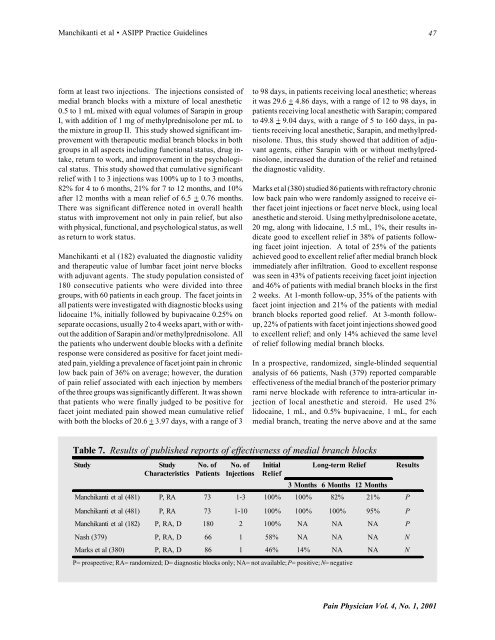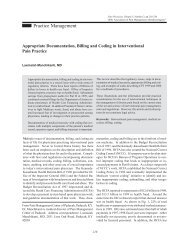ASIPP Practice Guidelines - Pain Physician
ASIPP Practice Guidelines - Pain Physician
ASIPP Practice Guidelines - Pain Physician
Create successful ePaper yourself
Turn your PDF publications into a flip-book with our unique Google optimized e-Paper software.
Manchikanti et al • <strong>ASIPP</strong> <strong>Practice</strong> <strong>Guidelines</strong><br />
47<br />
form at least two injections. The injections consisted of<br />
medial branch blocks with a mixture of local anesthetic<br />
0.5 to 1 mL mixed with equal volumes of Sarapin in group<br />
I, with addition of 1 mg of methylprednisolone per mL to<br />
the mixture in group II. This study showed significant improvement<br />
with therapeutic medial branch blocks in both<br />
groups in all aspects including functional status, drug intake,<br />
return to work, and improvement in the psychological<br />
status. This study showed that cumulative significant<br />
relief with 1 to 3 injections was 100% up to 1 to 3 months,<br />
82% for 4 to 6 months, 21% for 7 to 12 months, and 10%<br />
after 12 months with a mean relief of 6.5 + 0.76 months.<br />
There was significant difference noted in overall health<br />
status with improvement not only in pain relief, but also<br />
with physical, functional, and psychological status, as well<br />
as return to work status.<br />
Manchikanti et al (182) evaluated the diagnostic validity<br />
and therapeutic value of lumbar facet joint nerve blocks<br />
with adjuvant agents. The study population consisted of<br />
180 consecutive patients who were divided into three<br />
groups, with 60 patients in each group. The facet joints in<br />
all patients were investigated with diagnostic blocks using<br />
lidocaine 1%, initially followed by bupivacaine 0.25% on<br />
separate occasions, usually 2 to 4 weeks apart, with or without<br />
the addition of Sarapin and/or methylprednisolone. All<br />
the patients who underwent double blocks with a definite<br />
response were considered as positive for facet joint mediated<br />
pain, yielding a prevalence of facet joint pain in chronic<br />
low back pain of 36% on average; however, the duration<br />
of pain relief associated with each injection by members<br />
of the three groups was significantly different. It was shown<br />
that patients who were finally judged to be positive for<br />
facet joint mediated pain showed mean cumulative relief<br />
with both the blocks of 20.6 + 3.97 days, with a range of 3<br />
to 98 days, in patients receiving local anesthetic; whereas<br />
it was 29.6 + 4.86 days, with a range of 12 to 98 days, in<br />
patients receiving local anesthetic with Sarapin; compared<br />
to 49.8 + 9.04 days, with a range of 5 to 160 days, in patients<br />
receiving local anesthetic, Sarapin, and methylprednisolone.<br />
Thus, this study showed that addition of adjuvant<br />
agents, either Sarapin with or without methylprednisolone,<br />
increased the duration of the relief and retained<br />
the diagnostic validity.<br />
Marks et al (380) studied 86 patients with refractory chronic<br />
low back pain who were randomly assigned to receive either<br />
facet joint injections or facet nerve block, using local<br />
anesthetic and steroid. Using methylprednisolone acetate,<br />
20 mg, along with lidocaine, 1.5 mL, 1%, their results indicate<br />
good to excellent relief in 38% of patients following<br />
facet joint injection. A total of 25% of the patients<br />
achieved good to excellent relief after medial branch block<br />
immediately after infiltration. Good to excellent response<br />
was seen in 43% of patients receiving facet joint injection<br />
and 46% of patients with medial branch blocks in the first<br />
2 weeks. At 1-month follow-up, 35% of the patients with<br />
facet joint injection and 21% of the patients with medial<br />
branch blocks reported good relief. At 3-month followup,<br />
22% of patients with facet joint injections showed good<br />
to excellent relief; and only 14% achieved the same level<br />
of relief following medial branch blocks.<br />
In a prospective, randomized, single-blinded sequential<br />
analysis of 66 patients, Nash (379) reported comparable<br />
effectiveness of the medial branch of the posterior primary<br />
rami nerve blockade with reference to intra-articular injection<br />
of local anesthetic and steroid. He used 2%<br />
lidocaine, 1 mL, and 0.5% bupivacaine, 1 mL, for each<br />
medial branch, treating the nerve above and at the same<br />
Table 7. Results of published reports of effectiveness of medial branch blocks<br />
Study<br />
Study<br />
Characteristics<br />
No. of<br />
Patients<br />
No. of<br />
Injections<br />
Initial<br />
Relief<br />
Long-term Relief<br />
3 Months 6 Months 12 Months<br />
Manchikanti et al (481) P, RA 73 1-3 100% 100% 82% 21% P<br />
Manchikanti et al (481) P, RA 73 1-10 100% 100% 100% 95% P<br />
Manchikanti et al (182) P, RA, D 180 2 100% NA NA NA P<br />
Nash (379) P, RA, D 66 1 58% NA NA NA N<br />
Marks et al (380) P, RA, D 86 1 46% 14% NA NA N<br />
P= prospective; RA= randomized; D= diagnostic blocks only; NA= not available; P= positive; N= negative<br />
Results<br />
<strong>Pain</strong> <strong>Physician</strong> Vol. 4, No. 1, 2001
















